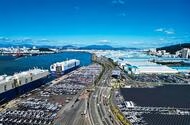Exploring the World’s Largest Car Factory: Hyundai’s Ulsan Plant
Imagine standing on a bridge overlooking a bustling dock, where thousands of gleaming new cars are lined up, ready to embark on journeys across the globe. This is the daily scene at Hyundai’s Ulsan plant, the largest car manufacturing facility in the world. Located on the southeastern coast of South Korea, this impressive site is not just about size; it’s a marvel of modern manufacturing and logistics.
How Many Cars Does Ulsan Produce?
The numbers are staggering. Hyundai’s Ulsan plant churns out an astonishing 1.5 million vehicles each year. To put that into perspective, that’s nearly double the total output of all 25 factories in the UK combined for 2024. In fact, this production level would have met 98% of all new car sales in Italy last year. It’s a clear indication of how pivotal this facility is in the global automotive landscape.
What Makes Ulsan Unique?
One of the standout features of the Ulsan plant is its strategic layout. Spanning a massive 1,200 acres—about the size of the quaint Bedfordshire town of Tilsworth—it houses five separate factories along with an engine and transmission plant. What truly sets it apart, however, is the on-site port. This unique feature allows for seamless operations, with 75% of the plant’s output shipped directly to over 200 countries. It’s a logistical dream that saves both time and money, enhancing Hyundai’s ability to meet global demand efficiently.
What Models Are Produced Here?
At Ulsan, a diverse lineup of 17 different models rolls off the production lines, including popular names like the Hyundai Santa Fe and Tucson, as well as the luxurious Genesis line. The production lines operate for 18 hours a day, showcasing the relentless pace of manufacturing. Excitingly, a sixth plant dedicated to electric vehicles is set to open next year, which will produce the highly anticipated Genesis GV90. This commitment to innovation and sustainability is a clear nod to the future of automotive manufacturing.
A Brief History of the Ulsan Plant
The Ulsan plant has a rich history that dates back to 1968, just a year after Hyundai was founded. Initially, it started as a modest assembly facility for Ford, where Cortinas were hand-built for the local market. Fast forward to today, and Ulsan has transformed into a colossal manufacturing hub. The sheer scale is evident as you drive through the site, where factory after factory stretches out before you, interspersed with around 600,000 trees that add a touch of greenery to the industrial landscape.
Inside the plant, you’ll find facilities that have evolved significantly over the decades. For example, Plant 5, which began operations in 1979 producing golf carts by hand, now manufactures high-end models like the Genesis G70 and G80, along with the Hyundai Palisade and hydrogen-fueled Nexo. The integration of electric battery production for the G80 further highlights the plant’s adaptability and forward-thinking approach.
How Does the Shipping Process Work?
Once vehicles are completed and pass rigorous quality control checks, they are swiftly transported to the dockside car park. Here, they are loaded onto massive roll-on/roll-off vessels, with a ship departing every 24 hours. This efficient shipping method is a key factor in Hyundai’s ability to maintain such high production levels. As cars are driven up a steep ramp onto the ship, it’s a sight to behold—drivers racing back down to prepare for the next batch of vehicles.
The Impact on Ulsan City
The city of Ulsan has grown exponentially alongside the plant, now home to approximately 1.1 million residents—comparable to Birmingham in the UK. When the factory first opened, the population was just 30,000, highlighting the transformative impact Hyundai has had on the region. Ulsan has evolved from a fishing port into South Korea’s industrial powerhouse, housing not only the Hyundai Ulsan plant but also Hyundai Heavy Industries, the world’s largest shipbuilding company, and one of the largest oil refineries globally.
Everywhere you look in Ulsan, the influence of Hyundai is palpable. From a motorway named after the company’s founder to hospitals, schools, and restaurants bearing the Hyundai name, the company’s legacy is woven into the fabric of the city.
Hyundai’s Ulsan plant is more than just a factory; it’s a symbol of ambition and innovation. The seamless integration of manufacturing and shipping, combined with the plant’s impressive output, showcases what can be achieved when vision meets execution. As the automotive industry continues to evolve, Ulsan stands as a testament to Hyundai’s commitment to excellence and its pivotal role in shaping the future of mobility.
The big takeaway? Hyundai’s Ulsan plant isn’t just about making cars; it’s about creating a blueprint for the future of manufacturing. If you’re looking to understand the heartbeat of the automotive industry, this is where you’ll find it.

